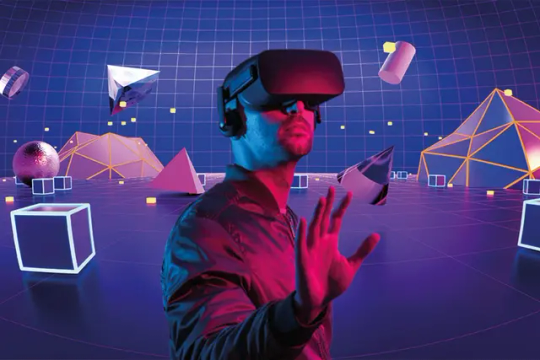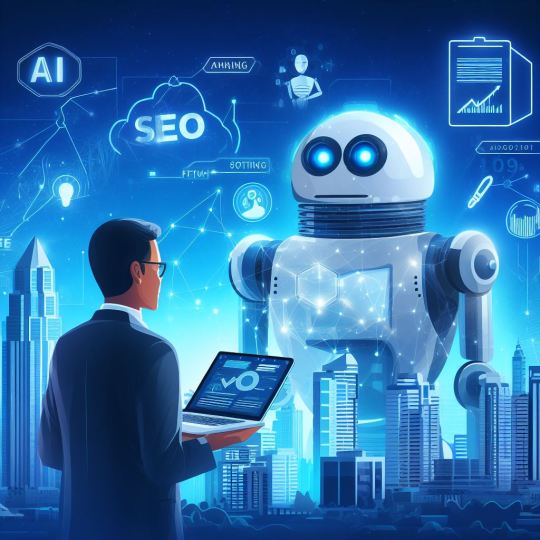#Custom Metaverse Environments
Explore tagged Tumblr posts
Text
As the metaverse continues to evolve, the demand for high-quality, engaging content has never been greater. This virtual universe is not just about immersive experiences; it’s also about the narratives, interactions, and creativity that bring those experiences to life. In India, one company stands out as a leader in this space: Simulanis Solutions. As a premier Metaverse Content Creation Company, Simulanis is dedicated to crafting compelling content that captivates users and enhances their journey through the metaverse.
#Metaverse Content Development#Metaverse Game Development#Virtual Reality Metaverse Content#Augmented Reality Metaverse Solutions#3D Metaverse Design#Immersive Metaverse Experiences#Metaverse App Development#Metaverse Animation Studio#Metaverse Platform Creation#Custom Metaverse Environments#Metaverse Virtual World Design#Metaverse Content Creation Agency#Metaverse Real Estate Development#Metaverse Architecture Services#Interactive Metaverse Solutions#Metaverse Digital Twins#Metaverse Experience Designers#NFT and Metaverse Content#Metaverse VR/AR Integration#Metaverse Integration Services
0 notes
Text
The Metaverse: A New Frontier in Digital Interaction

The concept of the metaverse has captivated the imagination of technologists, futurists, and businesses alike. Envisioned as a collective virtual shared space, the metaverse merges physical and digital realities, offering immersive experiences and unprecedented opportunities for interaction, commerce, and creativity. This article delves into the metaverse, its potential impact on various sectors, the technologies driving its development, and notable projects shaping this emerging landscape.
What is the Metaverse?
The metaverse is a digital universe that encompasses virtual and augmented reality, providing a persistent, shared, and interactive online environment. In the metaverse, users can create avatars, interact with others, attend virtual events, own virtual property, and engage in economic activities. Unlike traditional online experiences, the metaverse aims to replicate and enhance the real world, offering seamless integration of the physical and digital realms.
Key Components of the Metaverse
Virtual Worlds: Virtual worlds are digital environments where users can explore, interact, and create. Platforms like Decentraland, Sandbox, and VRChat offer expansive virtual spaces where users can build, socialize, and participate in various activities.
Augmented Reality (AR): AR overlays digital information onto the real world, enhancing user experiences through devices like smartphones and AR glasses. Examples include Pokémon GO and AR navigation apps that blend digital content with physical surroundings.
Virtual Reality (VR): VR provides immersive experiences through headsets that transport users to fully digital environments. Companies like Oculus, HTC Vive, and Sony PlayStation VR are leading the way in developing advanced VR hardware and software.
Blockchain Technology: Blockchain plays a crucial role in the metaverse by enabling decentralized ownership, digital scarcity, and secure transactions. NFTs (Non-Fungible Tokens) and cryptocurrencies are integral to the metaverse economy, allowing users to buy, sell, and trade virtual assets.
Digital Economy: The metaverse features a robust digital economy where users can earn, spend, and invest in virtual goods and services. Virtual real estate, digital art, and in-game items are examples of assets that hold real-world value within the metaverse.
Potential Impact of the Metaverse
Social Interaction: The metaverse offers new ways for people to connect and interact, transcending geographical boundaries. Virtual events, social spaces, and collaborative environments provide opportunities for meaningful engagement and community building.
Entertainment and Gaming: The entertainment and gaming industries are poised to benefit significantly from the metaverse. Immersive games, virtual concerts, and interactive storytelling experiences offer new dimensions of engagement and creativity.
Education and Training: The metaverse has the potential to revolutionize education and training by providing immersive, interactive learning environments. Virtual classrooms, simulations, and collaborative projects can enhance educational outcomes and accessibility.
Commerce and Retail: Virtual shopping experiences and digital marketplaces enable businesses to reach global audiences in innovative ways. Brands can create virtual storefronts, offer unique digital products, and engage customers through immersive experiences.
Work and Collaboration: The metaverse can transform the future of work by providing virtual offices, meeting spaces, and collaborative tools. Remote work and global collaboration become more seamless and engaging in a fully digital environment.
Technologies Driving the Metaverse
5G Connectivity: High-speed, low-latency 5G networks are essential for delivering seamless and responsive metaverse experiences. Enhanced connectivity enables real-time interactions and high-quality streaming of immersive content.
Advanced Graphics and Computing: Powerful graphics processing units (GPUs) and cloud computing resources are crucial for rendering detailed virtual environments and supporting large-scale metaverse platforms.
Artificial Intelligence (AI): AI enhances the metaverse by enabling realistic avatars, intelligent virtual assistants, and dynamic content generation. AI-driven algorithms can personalize experiences and optimize virtual interactions.
Wearable Technology: Wearable devices, such as VR headsets, AR glasses, and haptic feedback suits, provide users with immersive and interactive experiences. Advancements in wearable technology are critical for enhancing the metaverse experience.
Notable Metaverse Projects
Decentraland: Decentraland is a decentralized virtual world where users can buy, sell, and develop virtual real estate as NFTs. The platform offers a wide range of experiences, from gaming and socializing to virtual commerce and education.
Sandbox: Sandbox is a virtual world that allows users to create, own, and monetize their gaming experiences using blockchain technology. The platform's user-generated content and virtual real estate model have attracted a vibrant community of creators and players.
Facebook's Meta: Facebook's rebranding to Meta underscores its commitment to building the metaverse. Meta aims to create interconnected virtual spaces for social interaction, work, and entertainment, leveraging its existing social media infrastructure.
Roblox: Roblox is an online platform that enables users to create and play games developed by other users. With its extensive user-generated content and virtual economy, Roblox exemplifies the potential of the metaverse in gaming and social interaction.
Sexy Meme Coin (SEXXXY): Sexy Meme Coin integrates metaverse elements by offering a decentralized marketplace for buying, selling, and trading memes as NFTs. This unique approach combines humor, creativity, and digital ownership, adding a distinct flavor to the metaverse landscape. Learn more about Sexy Meme Coin at Sexy Meme Coin.
The Future of the Metaverse
The metaverse is still in its early stages, but its potential to reshape digital interaction is immense. As technology advances and more industries explore its possibilities, the metaverse is likely to become an integral part of our daily lives. Collaboration between technology providers, content creators, and businesses will drive the development of the metaverse, creating new opportunities for innovation and growth.
Conclusion
The metaverse represents a new frontier in digital interaction, offering immersive and interconnected experiences that bridge the physical and digital worlds. With its potential to transform social interaction, entertainment, education, commerce, and work, the metaverse is poised to revolutionize various aspects of our lives. Notable projects like Decentraland, Sandbox, Meta, Roblox, and Sexy Meme Coin are at the forefront of this transformation, showcasing the diverse possibilities within this emerging digital universe.
For those interested in the playful and innovative side of the metaverse, Sexy Meme Coin offers a unique and entertaining platform. Visit Sexy Meme Coin to explore this exciting project and join the community.
276 notes
·
View notes
Text
How the Metaverse Could Help Education Grow
Introduction
Education is undergoing rapid transformation thanks to emerging technologies, and the metaverse is poised to be a game-changer. But what exactly is the metaverse, and how can it contribute to the growth and improvement of education worldwide?
In this article, we’ll explore how the metaverse can revolutionize learning by making it more immersive, interactive, and accessible — transforming classrooms beyond physical boundaries.
What is the Metaverse?
The metaverse is a virtual, interconnected digital universe where users interact through avatars in 3D environments. It combines elements of virtual reality (VR), augmented reality (AR), artificial intelligence (AI), and blockchain to create realistic simulations and social experiences.
Unlike traditional online learning, the metaverse offers fully immersive educational environments that can simulate real-world or entirely new scenarios.
Ways the Metaverse Could Help Education Grow
1. Immersive Learning Experiences
Students can engage with subjects by stepping into virtual environments:
Explore ancient civilizations by walking through digital reconstructions of historical sites.
Conduct science experiments safely in virtual labs.
Visualize complex concepts like molecular structures or planetary systems in 3D.
This active learning helps improve retention and makes education exciting.
2. Remote Accessibility and Inclusivity
With the metaverse, students from remote or underserved areas can attend virtual schools, removing geographical barriers. It can also better support students with disabilities by customizing experiences to their needs.
3. Collaborative Virtual Classrooms
Instead of passively watching lectures, students can collaborate in real time within virtual classrooms — brainstorming on shared whiteboards, participating in group projects, or attending virtual office hours.
4. Gamification and Motivation
Educational games and quests embedded in the metaverse keep students motivated and engaged, turning learning into an enjoyable challenge rather than a chore.
5. Practical Skill Training
The metaverse can simulate real-world environments for vocational training — such as medical surgeries, mechanical repairs, or architectural design — allowing students to practice without risks or costs.

Benefits of Using the Metaverse in Education
Enhanced Engagement: Immersive environments capture attention better than textbooks or videos.
Better Understanding: Visual and interactive learning aids complex subject comprehension.
Personalized Learning: Virtual environments can adapt to individual student pace and style.
Global Classroom: Learners worldwide can connect, share ideas, and collaborate.
Cost-Effective Training: Virtual simulations reduce the need for expensive physical resources.
Challenges to Consider
While promising, metaverse-based education faces challenges such as:
Technology Access: Not all students have VR headsets or reliable internet.
Training Educators: Teachers need skills to design and deliver virtual lessons effectively.
Privacy Concerns: Protecting student data in immersive platforms is critical.
Content Quality: Ensuring accurate, unbiased, and high-quality educational content.
Real-World Examples
Universities like Stanford and Harvard are experimenting with virtual campuses and immersive courses.
Platforms like Engage and Virbela offer metaverse spaces for education and training.
Some companies, including We3 Vision Infotech, specialize in creating customized metaverse education solutions to help institutions and organizations innovate.
Conclusion
The metaverse holds incredible potential to help education grow by making learning more immersive, interactive, and accessible globally. While challenges remain, the ongoing technological advancements and increasing adoption signal a future where virtual classrooms are an integral part of education.
For institutions or educators looking to integrate the metaverse into their learning environments, partnering with expert developers like We3 Vision Infotech can provide the right tools and guidance.
2 notes
·
View notes
Text
A Metaverse Development Company is crucial for digital transformation because it provides the specialized knowledge and technical capabilities needed to build immersive digital experiences, redefining how businesses interact with customers and operate.

Introduction: The Central Role of a Metaverse Development Company in Digital Change
Digital transformation involves businesses using digital technology to change operations, culture, and customer interactions. While this concept has been discussed for years, the rise of the metaverse introduces a new, deeper level of digital change. No longer just about websites or apps, digital presence now includes interactive, persistent virtual worlds. This is where a Metaverse Development Company becomes not just helpful, but truly necessary. These specialized firms possess the unique blend of technical skill and creative vision required to build these new digital spaces, making them central to any organization aiming for full digital transformation. Understanding their role helps clarify why they are so important.
Key Reasons a Metaverse Development Company is Central to Digital Transformation
Engaging with a specialized Metaverse Development Company is a strategic move for businesses aiming to truly modernize and secure their future in the digital age. Their contributions go beyond simply creating virtual spaces; they enable fundamental shifts in how businesses operate and engage.
1. Building Immersive Customer Experiences Through Metaverse Development
Digital transformation aims to improve how customers interact with a business. A Metaverse Development Company pushes this further by creating immersive experiences that are much more engaging than traditional digital channels. Instead of just Browse, customers can virtually enter a store, try products, attend digital events, or even co-create with a brand. This level of interaction builds stronger connections and loyalty, moving digital engagement from passive viewing to active participation. This deeper customer connection is a core part of digital transformation.
2. Opening New Digital Channels for Business Growth
The metaverse represents a new digital channel for businesses, much like the internet once was. A Metaverse Development Company helps businesses establish a presence in this new space, expanding their reach beyond current markets. This means businesses can access a global audience without physical barriers, reach new customer groups, and find fresh ways to sell products and services. For example, a physical product can have a digital twin sold as an NFT, or a service can be offered in a virtual office. This expansion of digital channels is a clear sign of transformation.
3. Facilitating Innovation in Product and Service Delivery
A Metaverse Development Solution allows businesses to innovate at a faster pace. They can create virtual prototypes of products, conduct simulations for training, or even set up virtual research and development labs. This reduces the time and expense associated with physical prototyping and testing. Businesses can get immediate feedback from virtual users, quickly refine offerings, and bring new ideas to market faster. This ability to experiment and innovate in a digital sandbox is a strong driver of digital change, as it allows for quicker adaptation and refinement.
Ready to lead your industry's digital shift? Partner with a Metaverse Development Company to build your innovative virtual presence.
4. Enhancing Employee Collaboration and Training with Metaverse Development Services
Digital transformation also extends to internal operations. A Metaverse Development Company can build virtual workspaces and training environments that improve collaboration among distributed teams. Employees can meet in virtual offices, attend interactive training simulations, or work together on projects in shared 3D spaces, regardless of their physical location. This can lead to more engaging and effective learning experiences, reduce travel costs, and foster a more connected workforce. These Metaverse Development Services provide new tools for internal efficiency and development.
5. Strengthening Brand Identity in the Digital Sphere
In a world full of digital noise, standing out is hard. A Metaverse Development Company helps businesses create a distinct and memorable brand identity within immersive virtual spaces. Brands can design unique virtual environments that reflect their values and personality, offering users an active way to engage with their brand story. This deep, experiential branding builds stronger brand recognition and creates a forward-thinking image. For businesses undergoing digital transformation, establishing a strong, active presence in the metaverse is key to future brand relevance.
6. Staying Competitive and Future-Ready
Businesses that do not adapt to new digital shifts risk falling behind. Partnering with a Metaverse Development Company ensures a business remains competitive and prepared for future changes. By investing in Metaverse Development, companies show they are leaders in digital innovation. This proactive approach helps them attract new customers who use technology and position themselves as innovators in their industry. This readiness for future digital shifts is a fundamental part of true digital transformation, ensuring a business's long-term viability.
Conclusion: A Metaverse Development Company as a Partner in Digital Evolution
The journey of digital transformation is continuous, and the metaverse marks its next major phase. A Metaverse Development Company is not merely a service provider but a crucial partner in this evolution. By enabling immersive customer experiences, opening new digital channels, supporting rapid innovation, improving internal operations, strengthening brand presence, and ensuring competitive readiness, these specialized firms are central to helping businesses fully achieve their digital transformation goals. Engaging with a competent Metaverse Development Solution provider is a strategic move for any business aiming to secure its place in the digital future.
#metaverse#usa#australia#uae#japan#india#uk#singapore#metaverse service provider#metaversedesign#metaversedevelopment#metaverse development company#arvr
2 notes
·
View notes
Text
The Future of Social Media: Trends and Transformations by 2030
Social media has revolutionized how we connect, communicate, and consume content. But as we look ahead, it’s evident that platforms will undergo even more transformative changes. From the rise of artificial intelligence (AI) to immersive experiences in the metaverse, the future of social media is poised to reshape digital interaction. Let’s explore the key trends and innovations expected to define the next era of social media.
1. AI-Driven Personalization and Content Creation
AI algorithms will become more sophisticated, providing hyper-personalized content to users. Expect platforms to predict and curate content that aligns perfectly with individual preferences, reducing noise and enhancing engagement. Moreover, AI-driven tools will empower creators to produce high-quality videos, images, and written content with minimal effort. Chatbots and virtual influencers will also enhance brand-customer interactions, making customer support seamless.
2. The Rise of the Metaverse and Immersive Experiences
The concept of the metaverse will continue to gain traction, providing users with virtual spaces for social interaction, commerce, and entertainment. Social media platforms will integrate with virtual reality (VR) and augmented reality (AR) technologies, offering immersive experiences where users can attend events, shop, and interact in 3D environments. Expect virtual storefronts and branded virtual experiences to become common.
3. Decentralized Platforms and Digital Ownership
With growing concerns about data privacy and content ownership, decentralized social media networks powered by blockchain technology will emerge. These platforms will offer users more control over their data and provide transparency in content monetization. Non-Fungible Tokens (NFTs) will further enable digital ownership and monetization for creators. Users may own virtual spaces and digital art within the metaverse, fostering a more equitable digital economy.
4. Social Commerce Expansion
Social commerce will continue to thrive as platforms enhance in-app shopping experiences. Users will seamlessly discover, purchase, and review products without leaving the app. Livestream shopping, AR try-on features, and AI-driven recommendations will redefine e-commerce on social platforms. Direct payments and integrated wallets will make transactions smoother.
5. Ephemeral and Authentic Content Growth
Short-form, temporary content will remain popular, fostering authentic interactions. Features like stories, reels, and disappearing messages will encourage genuine connections, emphasizing relatability over perfection. Brands will leverage this trend to build trust and transparency with their audience.
6. Enhanced Influencer and Creator Economy
The creator economy will flourish, with platforms introducing more monetization options. Subscription models, virtual gifts, and exclusive content will provide creators with diversified income streams. Brands will increasingly collaborate with micro and nano influencers for more authentic brand promotions. Additionally, AI-powered content creation tools will allow creators to scale their output without compromising on quality.
7. AI-Powered Moderation and Ethical Considerations
To combat misinformation and ensure safer online environments, AI-powered moderation tools will play a pivotal role. Platforms will adopt advanced algorithms to detect harmful content while maintaining transparency and fairness in content governance. Ethical AI considerations will become a priority, ensuring responsible content management without compromising freedom of speech.
8. Sustainability and Social Impact
Social media platforms will focus on sustainability initiatives by promoting eco-friendly practices and reducing digital carbon footprints. Expect to see campaigns that emphasize environmental awareness and corporate social responsibility (CSR). Users will hold brands accountable for their sustainability efforts.
9. Multi-Platform Integration and Seamless Experiences
Future social media platforms will integrate seamlessly with other digital services. Cross-platform content sharing, unified notifications, and integrated messaging will enhance user convenience. AI assistants may help users navigate through multiple platforms effortlessly.
Conclusion
The future of social media is both exciting and dynamic. As technology evolves, so will the ways we engage, share, and connect. For businesses and creators, staying ahead of these trends will be essential to harness the full potential of emerging platforms.
Are you ready to embrace the future of social media? Stay informed, stay creative, and keep exploring the limitless possibilities that await in this ever-evolving digital landscape.

3 notes
·
View notes
Text
Top 10 Emerging Tech Trends to Watch in 2025
Technology is evolving at an unprecedented tempo, shaping industries, economies, and day by day lifestyles. As we method 2025, several contemporary technology are set to redefine how we engage with the sector. From synthetic intelligence to quantum computing, here are the important thing emerging tech developments to look at in 2025.

Top 10 Emerging Tech Trends In 2025
1. Artificial Intelligence (AI) Evolution
AI remains a dominant force in technological advancement. By 2025, we will see AI turning into greater sophisticated and deeply incorporated into corporations and personal programs. Key tendencies include:
Generative AI: AI fashions like ChatGPT and DALL·E will strengthen similarly, generating more human-like textual content, images, and even films.
AI-Powered Automation: Companies will more and more depend upon AI-pushed automation for customer support, content material advent, and even software development.
Explainable AI (XAI): Transparency in AI decision-making becomes a priority, ensuring AI is greater trustworthy and comprehensible.
AI in Healthcare: From diagnosing sicknesses to robot surgeries, AI will revolutionize healthcare, reducing errors and improving affected person results.
2. Quantum Computing Breakthroughs
Quantum computing is transitioning from theoretical studies to real-global packages. In 2025, we will expect:
More powerful quantum processors: Companies like Google, IBM, and startups like IonQ are making full-size strides in quantum hardware.
Quantum AI: Combining quantum computing with AI will enhance machine studying fashions, making them exponentially quicker.
Commercial Quantum Applications: Industries like logistics, prescribed drugs, and cryptography will begin leveraging quantum computing for fixing complex troubles that traditional computer systems can not manage successfully.
3. The Rise of Web3 and Decentralization
The evolution of the net continues with Web3, emphasizing decentralization, blockchain, and user possession. Key factors consist of:
Decentralized Finance (DeFi): More economic services will shift to decentralized platforms, putting off intermediaries.
Non-Fungible Tokens (NFTs) Beyond Art: NFTs will find utility in actual estate, gaming, and highbrow belongings.
Decentralized Autonomous Organizations (DAOs): These blockchain-powered organizations will revolutionize governance systems, making choice-making more obvious and democratic.
Metaverse Integration: Web3 will further integrate with the metaverse, allowing secure and decentralized digital environments.
4. Extended Reality (XR) and the Metaverse
Virtual Reality (VR), Augmented Reality (AR), and Mixed Reality (MR) will retain to improve, making the metaverse extra immersive. Key tendencies consist of:
Lighter, More Affordable AR/VR Devices: Companies like Apple, Meta, and Microsoft are working on more accessible and cushty wearable generation.
Enterprise Use Cases: Businesses will use AR/VR for far flung paintings, education, and collaboration, lowering the want for physical office spaces.
Metaverse Economy Growth: Digital belongings, digital real estate, and immersive studies will gain traction, driven via blockchain technology.
AI-Generated Virtual Worlds: AI will play a role in developing dynamic, interactive, and ever-evolving virtual landscapes.
5. Sustainable and Green Technology
With growing concerns over weather alternate, generation will play a vital function in sustainability. Some key innovations include:
Carbon Capture and Storage (CCS): New techniques will emerge to seize and keep carbon emissions efficaciously.
Smart Grids and Renewable Energy Integration: AI-powered clever grids will optimize power distribution and consumption.
Electric Vehicle (EV) Advancements: Battery generation upgrades will cause longer-lasting, faster-charging EVs.
Biodegradable Electronics: The upward thrust of green digital additives will assist lessen e-waste.
6. Biotechnology and Personalized Medicine
Healthcare is present process a metamorphosis with biotech improvements. By 2025, we expect:
Gene Editing and CRISPR Advances: Breakthroughs in gene modifying will enable treatments for genetic disorders.
Personalized Medicine: AI and big statistics will tailor remedies based on man or woman genetic profiles.
Lab-Grown Organs and Tissues: Scientists will make in addition progress in 3D-published organs and tissue engineering.
Wearable Health Monitors: More superior wearables will music fitness metrics in actual-time, presenting early warnings for illnesses.
7. Edge Computing and 5G Expansion
The developing call for for real-time statistics processing will push aspect computing to the vanguard. In 2025, we will see:
Faster 5G Networks: Global 5G insurance will increase, enabling excessive-velocity, low-latency verbal exchange.
Edge AI Processing: AI algorithms will system information in the direction of the source, reducing the want for centralized cloud computing.
Industrial IoT (IIoT) Growth: Factories, deliver chains, and logistics will advantage from real-time facts analytics and automation.
Eight. Cybersecurity and Privacy Enhancements
With the upward thrust of AI, quantum computing, and Web3, cybersecurity will become even more essential. Expect:
AI-Driven Cybersecurity: AI will come across and prevent cyber threats extra effectively than traditional methods.
Zero Trust Security Models: Organizations will undertake stricter get right of entry to controls, assuming no entity is inherently sincere.
Quantum-Resistant Cryptography: As quantum computer systems turn out to be greater effective, encryption techniques will evolve to counter potential threats.
Biometric Authentication: More structures will rely on facial reputation, retina scans, and behavioral biometrics.
9. Robotics and Automation
Automation will hold to disrupt numerous industries. By 2025, key trends encompass:
Humanoid Robots: Companies like Tesla and Boston Dynamics are growing robots for commercial and family use.
AI-Powered Supply Chains: Robotics will streamline logistics and warehouse operations.
Autonomous Vehicles: Self-using automobiles, trucks, and drones will become greater not unusual in transportation and shipping offerings.
10. Space Exploration and Commercialization
Space era is advancing swiftly, with governments and private groups pushing the boundaries. Trends in 2025 include:
Lunar and Mars Missions: NASA, SpaceX, and other groups will development of their missions to establish lunar bases.
Space Tourism: Companies like Blue Origin and Virgin Galactic will make industrial area travel more reachable.
Asteroid Mining: Early-level research and experiments in asteroid mining will start, aiming to extract rare materials from area.
2 notes
·
View notes
Text
Keys to the Digital Future
The digital future is not merely a continuation of today’s technological trends; it is a transformative landscape where innovation, connectivity, and sustainability intertwine to redefine how we live, work, and interact. As we step into this exciting future, understanding its essential components can empower individuals, businesses, and societies to thrive. Here are the key elements shaping the digital future:
Artificial Intelligence (AI) and Machine Learning (ML)
AI and ML are at the forefront of the digital transformation. These technologies are driving advancements in automation, data analysis, and decision-making. From personalized recommendations to autonomous vehicles, AI’s capabilities are reshaping industries. The future lies in ethical AI development, ensuring these tools enhance human lives while minimizing biases and risks.
The Internet of Things (IoT)
The IoT connects devices, systems, and people, creating an ecosystem of interconnectivity. Smart homes, wearables, and industrial IoT solutions are just the beginning. As 5G and edge computing mature, IoT’s potential to streamline operations and improve efficiency will expand exponentially, transforming everything from healthcare to urban planning.
3. Sustainable Technologies
The digital future must align with global sustainability goals. Renewable energy, energy-efficient data centers, and green computing practices are essential for reducing the environmental footprint of technology. The circular economy, which emphasizes recycling and repurposing electronic waste, will play a significant role in creating a sustainable digital ecosystem.
Cybersecurity and Privacy
As technology evolves, so do the threats associated with it. Cybersecurity is a cornerstone of the digital future, requiring robust frameworks to protect data and infrastructure. Privacy-centric technologies, such as blockchain and zero-knowledge proofs, offer innovative ways to safeguard user data and build trust in digital systems.
Digital Inclusion and Accessibility
A truly transformative digital future is one that is inclusive and accessible to all. Bridging the digital divide requires investments in infrastructure, affordable devices, and digital literacy programs. Technologies must be designed with accessibility in mind, ensuring equitable opportunities for everyone, regardless of location, ability, or socioeconomic status.
Quantum Computing
Quantum computing has the potential to solve problems that are currently beyond the reach of classical computers. By leveraging quantum mechanics, these machines can revolutionize fields such as cryptography, drug discovery, and climate modeling. While still in its infancy, quantum computing is a critical component of the digital frontier.
The Metaverse and Virtual Realities
The metaverse represents the convergence of physical and digital realities. Virtual and augmented reality technologies are enabling new ways of interaction, education, and entertainment. Businesses are leveraging these immersive environments for training, product design, and customer engagement, laying the foundation for a blended digital-physical world.
Ethical Leadership in Technology
The digital future demands leaders who prioritize ethics and societal well-being. From addressing algorithmic biases to ensuring responsible AI deployment, ethical leadership is crucial for fostering innovation that aligns with human values. Transparency, accountability, and collaboration will be key to navigating complex ethical challenges.
Education and Lifelong Learning
As technology evolves, so must our skills. The future workforce will require adaptability and continuous learning to keep pace with new tools and paradigms. Education systems must evolve to emphasize digital literacy, critical thinking, and collaboration, preparing individuals for the demands of a rapidly changing digital landscape.
Global Collaboration
The digital future is a global endeavor, requiring collaboration across borders, industries, and disciplines. Shared goals, such as mitigating climate change and advancing healthcare, necessitate partnerships that leverage collective expertise and resources. International cooperation will ensure that technological advancements benefit humanity as a whole.
The keys to the digital future lie in innovation, inclusivity, and sustainability. By embracing these principles and addressing the challenges they present, we can unlock unprecedented opportunities for growth and prosperity. As we navigate this dynamic journey, the digital future promises to be a realm of endless possibilities, limited only by our imagination and commitment to shaping it responsibly.
2 notes
·
View notes
Text
Blog Post #01- Fashion in the Metaverse
In this article, I will try to discuss the transformative effect of the metaverse on the fashion industry, underlining virtual fashion events. I will discuss in detail how luxury brands like Gucci, Balenciaga, and Ralph Lauren are using Roblox, Fortnite, and Decentraland to reach their audiences in new and innovative ways. I will also touch on the great role that sustainability plays in these virtual fashion events and how these brands are using the metaverse to reduce their environmental impact and redefine the future of fashion. ------------------------------------------------------------------------------ To begin with, let's talk about Decentraland and its role in hosting one of the first big digital fashion events—'Metaverse Fashion Week' in 2022. The event, which was virtual, saw possibilities opening up for digital fashion and showed how brands were actually moving away from traditional, physical showcases toward virtual engagement. In the metaverse, fashion shows are no longer bound by the costs of travel, arrangement of set-ups, and resource-intensive activities. Instead of the old ways, brands can create immersive virtual environments that attract audiences worldwide without carbon emissions. Decentraland provides a canvas for designers and brands to create bespoke, interactive spaces. These spaces allow brands to reach their audience in many ways, such as through fashion shows, virtual retail stores, and pop-up shops.
Moreover, virtual fashion shows are sustainable. The traditional fashion weeks come with a huge environmental price tag, that is, the transportation of models, designers, and collections, including the disposal of unsold garments. Virtual fashion events mitigate a huge volume of waste by offering digital portrayals of fashion collections. Consequently, these virtual events make it possible for brands to create digital representations of clothes instead of physical ones, therefore reducing overproduction and waste.
What interests me the most about virtual fashion is its ability to create on-demand clothing, which may also help reduce overproduction. By offering digital garments for virtual avatars, brands can reduce their ecological footprint.
Luxury brands like Gucci, Balenciaga, and Ralph Lauren are leading the charge into the metaverse with virtual fashion events on Roblox, Fortnite, and Decentraland. These digital spaces give brands new unique opportunities to engage with their consumers in ways that are more sustainable, immersive, and interactive while answering growing interest in digital fashion.
------------------------------------------------------------------------------
Luxury Labels in Virtual Fashion
Gucci: The Gucci Garden on Roblox
youtube
Here I want to throw light on the Gucci's 'Gucci Garden on Roblox', which is among the most inventive instances of virtual fashion. Launched in 2021, this immersive experience let users explore a virtual recreation of Venice that was created with the city's distinctive architectural brilliance in mind. There were themed rooms in this vibrant areas that represented various Gucci collections. According to Forc Magazine, the Gucci Garden was much more than a digital fashion show: visitors could buy virtual items, interact with the environment, customize their avatars, and be fully immersed in the world of Gucci.


The virtual fashion environment is most intriguing because it merges architectural components with fashion, hence creating something entirely new and unique. This example shows that brands can actually collaborate with the metaverse in order to come up with unique, sustainable fashion experiences.
------------------------------------------------------------------------------
Balenciaga: Collaboration with Fortnite

Next, I would like to talk about the collaboration between Balenciaga and Epic Games' Fortnite that took place in 2021. This collaboration marked a huge step in the development of digital fashion, as it gave Fortnite players a chance to dress their avatars in Balenciaga's virtual clothes. Here, we see how fashion may break the barrier of conventional shop windows and penetrate the virtual worlds, where users can also express their identity through their avatars. By selling virtual clothes and accessories, Balenciaga has succeeded in engaging younger audiences by demonstrating the potential for fashion to be effortlessly integrated into digital contexts. This collaboration will be important, first, because it underlines the emerging market that gaming platforms present for fashion brands. It also underlines the growing importance of virtual fashion within gaming communities, where digital assets are held in as high regard as their physical counterparts. I will therefore argue that with the increasing trend of fashion houses turning to online platforms for greater visibility and generation of revenue, this trend is only going to grow much stronger.
------------------------------------------------------------------------------
Ralph Lauren: The RL Virtual Experience

Lastly, it has to be recognized that Ralph Lauren's significant step into the metaverse was realized with the launch of The RL Virtual Experience in 2021. This interactive virtual shopping experience allowed users to navigate through Ralph Lauren's collections in a digital space that replicated the level of refinement and sophistication of their physical stores. The project was envisioned to deliver a similar level of exclusivity and upscale retail experience typical of the flagship stores linked with Ralph Lauren; in this case, though, it was realized in only a virtual version.

The thing that is most striking about the RL Virtual Experience is the integration of technology with luxury. In a sense, Ralph Lauren has almost reduced the ecological footprint of traditional retail by offering a virtual in-store experience, while simultaneously providing an entertaining and personalized shopping experience for its consumers. The transition into virtual environments is a clear sign of the future direction that fashion will take, where digital spaces are likely to play a far more important role in customer experience and engagement with brands.
------------------------------------------------------------------------------
Taking everything into consideration, the growing number of virtual fashion events within the metaverse is a clear testimony to the fact that the fashion industry has finally accepted new developments in digital technology and sustainability. Platforms like Decentraland, Roblox, and Fortnite offer brands the tools needed to create an immersive and interactive experience that reduces environmental impact while offering consumers new ways of engaging with fashion. There is an expected gradual move towards virtual fashion, noted for principles such as originality, sustainability, and accessibility, as brands like Ralph Lauren, Gucci, and Balenciaga keep on exploring these digital landscapes.
This move to virtual fashion shows, in my opinion, is a positive step for the sector. It encourages innovation, gives firms new avenues to connect with consumers throughout the world, and helps ensure that fashion has a more sustainable future.
Sources
Decentraland. (2022). The First Metaverse Fashion Week. Available at: https://www.decentraland.org [Accessed 26 December 2024].
Landvault. (2021). Fashion Brands in the Metaverse. Available at: https://landvault.io/blog/fashion-brands-metaverse [Accessed 26 December 2024].
Fashinnovation. (2021). Virtual Runway: Is Digital the Future of Fashion?. Available at: https://fashinnovation.nyc/virtual-runway-is-digital-the-future-of-fashion/ [Accessed 26 December 2024].
Forc Magazine. (2021). The Gucci Garden on Roblox: An Immersive Virtual Experience. Available at: https://www.forc.com [Accessed 26 December 2024].
Gucci. (2021). Gucci Garden on Roblox: An Immersive Virtual Experience. Available at: https://www.gucci.com [Accessed 26 December 2024].
Balenciaga. (2021). Balenciaga Partners with Fortnite. Available at: https://www.balenciaga.com [Accessed 26 December 2024].
Ralph Lauren. (2021). The RL Virtual Experience. Available at: https://www.ralphlauren.com [Accessed 26 December 2024].
Forbes. (2020). Ralph Lauren: A Virtual Store Experience that Will Change Shopping Forever. Available at: https://www.forbes.com/sites/josephdeacetis/2020/11/27/ralph-lauren-a-virtual-store-experience-that-will-change-shopping-forever/ [Accessed 26 December 2024].
2 notes
·
View notes
Text
How Blockchain & AI Are Powering the Future of Metaverse Development
Introduction: The Tech Duo Redefining Metaverse Development
In today's digital revolution, blockchain and AI are the backbone of metaverse development. These technologies are not just enhancing virtual worlds but also creating secure and immersive ecosystems for businesses and users alike. With blockchain providing transparency and security, and AI delivering intelligent automation, the metaverse is evolving into a more engaging and efficient platform.
What is Metaverse?
The metaverse is a 3D virtual space that blends augmented reality (AR), virtual reality (VR), blockchain, and AI to offer interactive experiences. Users can socialize, conduct business, and explore virtual environments with real-time interactions.
What is Metaverse Marketing?
Metaverse marketing leverages virtual environments to engage audiences. It includes virtual storefronts, interactive brand experiences, and digital advertising through virtual billboards. Brands can host virtual events, product launches, and even customer service interactions to build stronger connections with their audience.

Why Metaverse is Important for Business
The metaverse opens doors for businesses to connect with customers, host virtual events, and offer unique digital experiences. It allows brands to reach global audiences, enhance customer engagement, and create new revenue streams through virtual assets and NFTs.
What Makes Blockchain and AI the Core of Metaverse Growth?
Blockchain Basics: Securing the Metaverse
Secure and transparent transactions: Blockchain records every transaction on a decentralized ledger, ensuring transparency.
Ownership verification through NFTs: Non-fungible tokens (NFTs) allow users to own digital assets securely.
Data protection and privacy: Blockchain encryption protects user data and prevents unauthorized access.
Decentralized control of digital assets: Users have complete control over their virtual assets without intermediaries.
AI’s Magic Touch: Bringing Metaverse Worlds to Life
Realistic virtual environments: AI generates lifelike environments and enhances user interaction.
Intelligent virtual avatars: AI-driven avatars can respond and adapt to user behavior.
Predictive analytics: AI analyzes user data to provide personalized experiences.
Automated content creation: AI tools can design virtual worlds and characters efficiently.
Real-World Wins: Blockchain and AI in Metaverse Projects
Gaming in the Metaverse: Where Blockchain Meets AI
In metaverse gaming platforms, blockchain enables secure in-game asset ownership, while AI enhances character interactions and game environments. This combination allows players to trade digital assets and enjoy lifelike gaming experiences.
Virtual Economies: How Blockchain and AI Create Value
Blockchain-based tokens and NFTs: Allow users to buy, sell, and trade virtual assets.
AI-driven analytics: Helps businesses understand user behavior and optimize virtual economy strategies.
Smart contract-based financial systems: Ensures fair and automated transactions.
Secure data storage: Protects sensitive information on decentralized networks.
Why Blockchain and AI Are the Heart of Metaverse Development Solutions
Metaverse Development Basics: Where Blockchain and AI Shine
Blockchain guarantees data security and asset ownership, while AI automates processes and delivers intelligent interactions. Together, they drive innovation and scalability.
How Blockchain Secures Metaverse Application Development
Decentralized networks for data security: Protects against cyberattacks and data breaches.
Smart contract automation: Enables transparent and efficient transactions.
Ownership verification through NFTs: Ensures authenticity and uniqueness of virtual assets.
Fraud prevention mechanisms: Reduces the risk of unauthorized access and manipulation.
Metaverse Development Services Fueled by AI and Blockchain
What Metaverse Development Services Gain from AI Innovation
AI enhances virtual customer support, generates virtual content, and provides advanced analytics to improve customer satisfaction.
Blockchain’s Role in Metaverse Gaming Platform Development
Blockchain enables secure tokenization, NFT integration, and decentralized asset management. This technology allows players to own in-game assets and trade them across different platforms.
Who’s Building the Future? Metaverse Development Company in Action
Malgo is leading the charge in metaverse development by leveraging blockchain and AI technologies. Their expertise in building secure, scalable, and immersive platforms makes them the ideal choice for businesses aiming to dominate the virtual world.
Picking a Metaverse Development Company That Delivers
Assess blockchain and AI expertise: Check the company’s technical capabilities.
Review customer feedback: Analyze past client reviews and testimonials.
Evaluate customization options: Ensure flexibility in development services.
Ensure data security compliance: Verify adherence to security protocols.
Inside a Metaverse App Development Company: AI and Blockchain at Work
A metaverse development company integrates AI for intelligent features and blockchain for secure asset management. This ensures seamless virtual experiences and secure digital ownership.
The Next Big Leap: Metaverse Development Trends to Watch
AI-Driven Features Shaping Metaverse Development Solutions
AI-powered avatars, predictive analytics, and automated content generation are transforming user experiences in the metaverse. These features enhance user engagement and offer personalized virtual environments.
Blockchain-Powered Ownership in Metaverse Gaming Platform Development
NFT-based ownership of virtual items: Enables secure trading of unique assets.
Smart contract-driven transactions: Ensures transparency and fairness.
Decentralized financial systems: Supports secure and instant payments.
Cross-platform compatibility: Allows seamless asset transfer between platforms.
Final Thoughts: Blockchain, AI, and the Metaverse Development
The fusion of blockchain and AI is shaping the future of metaverse development. Build your virtual empire with advanced Metaverse Development solutions today! With blockchain ensuring security and transparency and AI enhancing user experiences and automation, businesses can create immersive virtual platforms. For businesses aiming to thrive in the virtual world, partnering with Malgo is the perfect choice to build secure, scalable, and immersive metaverse platforms.
1 note
·
View note
Text


Navigating the Evolving Travel Trends: Past, Present, and Future✈️




The past five years have seen the travel industry undergo a seismic shift, shaped by unforeseen circumstances, evolving priorities, and technological advancements.

Past Trends (2019-2024):
1. Rise of Staycations and Local Travel: With global uncertainty, people sought comfort in familiar surroundings, boosting local tourism and staycations. This trend also fueled the popularity of unique, nearby experiences like glamping or micro-adventures.
2. Experiences over Destinations: Travelers craved deeper connections and immersion, prioritizing authentic experiences over simply ticking off landmarks. This led to a surge in cultural tours, voluntourism, and off-the-beaten-path adventures.
3. Bleisure Travel: The lines between business and leisure blurred as remote work options became more prevalent. Travelers extended business trips to include leisure activities, driving demand for flexible booking options and co-working spaces in tourist destinations.
4. Sustainability in Focus: Environmental consciousness grew, leading to a rise in eco-friendly travel choices. Travelers sought out sustainable accommodations, responsible tours, and destinations committed to conservation.
5. Tech-Driven Transformation: Technology played an increasingly crucial role, from AI-powered travel recommendations to contactless payments and immersive virtual tours. This trend also fueled the growth of travel apps and online booking platforms.

Possible Future Trends (2024-2029):
1. Hyper-Personalization: Travel will become increasingly tailored to individual preferences, with AI and machine learning creating bespoke itineraries and experiences based on unique interests, travel styles, and budgets.
2. Wellness & Retreats: The focus on mental and physical wellbeing will continue, with travelers seeking destinations and experiences that promote mindfulness, relaxation, and holistic rejuvenation.
3. Transformative Travel: The desire for personal growth and self-discovery will drive demand for transformative travel experiences, such as volunteering, cultural immersion programs, and journeys focused on personal development.
4. Space Tourism: As technology advances and costs decrease, space tourism could become more accessible, offering a unique and futuristic travel experience for a select few.
5. Metaverse Travel: Virtual and augmented reality experiences will continue to evolve, potentially offering immersive travel simulations that allow people to explore destinations without physically being there.

The past five years have painted a dynamic picture of travel trends. Driven by changing lifestyles, social values, and technological advancements, travelers have embraced experiences over mere sightseeing, pursued self-discovery through solo adventures, and sought responsible, personalized journeys.
Looking ahead, several exciting possibilities emerge. Hyper-personalization will be key, with tech facilitating highly customized itineraries that resonate deeply with individual aspirations. Wellness and retreat travel will boom, as people seek mental, physical, and spiritual rejuvenation. Additionally, destination stewardship will take center stage, with travelers actively partnering with locals to preserve cultures and environments.
This evolving landscape presents both challenges and opportunities. The travel industry must adapt to offer personalized experiences at scale, cater to the growing wellness market, and integrate sustainable practices seamlessly. Travelers, meanwhile, have the power to choose wisely, supporting responsible tourism and contributing to positive change.
While technology will play a vital role, human connection will remain paramount. Authentic interactions, cultural immersion, and meaningful experiences will be the true differentiators in this new era of travel. Ultimately, the future of travel promises a deeper, more personalized, and responsible way to explore the world, driven by our collective desire for connection, transformation, and discovery.
These are just a glimpse into the ever-evolving world of travel. As we move forward, sustainability, personalization, and transformative experiences will likely take center stage, while technology will continue to reshape how we plan, book, and experience travel. The future of travel promises to be exciting, diverse, and deeply attuned to the evolving needs and desires of travelers worldwide.

#travel writing & photography#travel writing#travel#adventure#blog#writing#trends#gif anime#gifset#dividers#cute#div cr plutism
9 notes
·
View notes
Text

Tools and Methods for Extracting Metaverse VR Using XMLTV EPG Grabber
Metaverse VR has become an increasingly popular and immersive way for people to interact and engage with digital environments.
One of the key aspects of the Metaverse VR experience is the ability to access Electronic Program Guide (EPG) data to discover and schedule virtual events, shows, and activities.
In this blog post, we'll explore various tools and methods available for extracting Metaverse VR data using epg grabber.
What is XMLTV EPG Grabber?
XMLTV is a set of programs to process TV (tvguide) listings and help manage your TV viewing, recording, and scheduling. XMLTV EPG grabber is a tool specifically designed to extract EPG data from various sources and provide a standardized XML format for TV listings.
This format can be utilized to populate electronic program guides in various applications, including those for Metaverse VR experiences.
Tools for Extracting Metaverse VR Using XMLTV EPG Grabber
1. XMLTV GUI Grabber
XMLTV GUI Grabber is a user-friendly graphical interface tool that allows users to easily configure and run XMLTV grabbers. It provides a simple way to select sources, set up grabber options, and initiate the extraction process. This tool is suitable for users who prefer a more intuitive and visually guided approach to EPG data extraction.
2. Web-based XMLTV Grabbers
There are several web-based services and tools that offer XMLTV EPG grabber functionality. These platforms typically allow users to input their desired sources and parameters, and then generate XMLTV-compatible output for consumption in Metaverse VR applications.
Web-based grabbers are accessible from any device with an internet connection, making them convenient for users who require flexibility in their data extraction process.
3. Custom Scripting and Automation
For users with specific requirements or unique sources for Metaverse VR EPG data, custom scripting and automation can be employed to extract and format the XMLTV data. This method involves writing custom scripts or utilizing automation tools to retrieve and process EPG data from different sources, providing a high degree of customization and flexibility.
Methods for Utilizing Extracted EPG Data in Metaverse VR
Once the EPG data has been extracted using XMLTV grabbers, there are several methods for utilizing this data within the Metaverse VR environment:
Integration with Virtual Event Scheduling: EPG data can be integrated into virtual event scheduling systems within the Metaverse VR, allowing users to discover and RSVP to upcoming virtual events and experiences.
Customized Virtual TV Guide: The extracted EPG data can be used to create a customized virtual TV guide within the Metaverse VR, enabling users to browse and select virtual shows and broadcasts to attend.
Personalized Notifications and Reminders: Utilizing the extracted EPG data, personalized notifications and reminders can be sent to users within the Metaverse VR to ensure they don't miss out on their favorite virtual events or activities.
XMLTV EPG grabbers provide a valuable means of extracting xmltv epg format for use within the Metaverse VR. Whether through user-friendly graphical interfaces, web-based services, or custom scripting, these tools and methods empower users to enrich their virtual experiences with relevant and up-to-date content.
By leveraging the extracted EPG data, developers and content creators can enhance the richness and interactivity of the Metaverse VR environment, offering users a more immersive and engaging virtual experience.
Developing Mixed Reality Applications with XMLTV Data
Mixed Reality (MR) applications have been gaining traction in recent years, revolutionizing the way we interact with our digital environment. A key factor in the improvement of XMLTV data for parsing and presentation. This comprehensive guide will introduce you to the world of XMLTV data parsing and the role it plays in the development of MR applications. We'll also delve into open-source tools and scripts that can enhance your MR development experience.
Understanding XMLTV in the Context of Mixed Reality
XMLTV is a standard that is primarily used for the interchange of TV program schedule information. However, its versatile nature allows it to be adapted for use in the development of MR applications.
XMLTV Data Parsing
XMLTV data parsing is a method of extracting useful information from XMLTV feeds. This data can be used to populate the EPG (Electronic Program Guide) of a MR application, providing users with information on available programs.
Metaverse on XMLTV technology
The metaverse, a collective virtual shared space created by the convergence of physical and virtual reality, can benefit from the use of XMLTV technology. XMLTV data can be used to create a more immersive and interactive experience for users in the metaverse.
Integrating VR CGI and XMLTV
Virtual Reality (VR) Computer Generated Imagery (CGI) can be integrated with XMLTV data to create more realistic and engaging MR experiences. This integration can also enhance the user's sense of presence in the MR environment.
Open-Source Tools and Scripts for XMLTV Data Parsing
There are numerous open-source tools and scripts available for XMLTV data parsing. These tools help developers to parse, manipulate, and present XMLTV data in their MR applications.
TVHeadEnd
TVHeadEnd is an open-source TV streaming server and recorder that supports XMLTV data. It can parse and save XMLTV data into the EPG database, providing a crucial function for MR applications.
M3U
M3U is a simple text format that can be used to create playlists and organize XMLTV data. It can be used in conjunction with XMLTV data to create a more structured and user-friendly EPG.
XPath
XPath is a language that is used to navigate through elements and attributes in XML documents. It can be used to identify specific nodes or attributes in xmltv descriptions that contain useful EPG information.
StereoKit
StereoKit is an open-source mixed reality library for building HoloLens, VR, and desktop experiences. It can be used to create cross-platform MR experiences with C# and OpenXR.
Building Interactive Mixed Reality Interfaces in XMLTV Data Parsing and Presentation
Building interactive MR interfaces using XMLTV data parsing and presentation involves several steps. These include setting up your development environment, parsing the XMLTV data, creating the MR interface, and testing the application.
Setting Up Your Development Environment
Before you can start developing your MR application, you need to set up your development environment. This typically involves installing the necessary software and hardware, such as a MR headset, a development IDE, and the necessary SDKs.
Parsing XMLTV Data
Once your development environment is set up, you can start parsing the XMLTV data. This involves extracting useful information from the XMLTV feed and saving it into your application's EPG database.
Creating the MR Interface
After parsing the XMLTV data, you can start creating the MR interface. This involves designing and implementing the user interface elements, such as menus, controls, and displays.
Testing the Application
Once the MR interface is complete, you can start testing your application. This involves checking the functionality of the application and ensuring that the XMLTV data is correctly parsed and presented.
Developing mixed reality applications using XMLTV data involves a combination of data parsing, interface design, and application testing. By understanding the role of XMLTV data in MR development and utilizing the available open-source tools and scripts, you can create engaging and interactive MR applications. So, dive into the world of XMLTV and explore how it can enhance your MR development experience.
youtube
3 notes
·
View notes
Text
In today’s rapidly evolving digital landscape, the concept of the metaverse has gained significant traction. As businesses and individuals seek to create immersive experiences that bridge the gap between the physical and virtual worlds, companies like Simulanis Solutions have emerged as leaders in this innovative space. As a premier Metaverse Development Company, Simulanis is dedicated to pushing the boundaries of what’s possible in digital interaction
#Metaverse Development Services#Metaverse Solutions Provider#Metaverse Platform Development#Custom Metaverse Development#Metaverse Game Development#Metaverse App Development#3D Metaverse Development#Blockchain Metaverse Development#Metaverse Experience Design#Metaverse VR/AR Integration#Virtual Worlds Development#Metaverse Virtual Reality Development#NFT Integration in Metaverse#Interactive Metaverse Solutions#Metaverse for Business Solutions#Metaverse Environment Creation#Metaverse Real Estate Development#Next-gen Metaverse Development#Metaverse Integration Services#Metaverse Customization Services
0 notes
Text
What is the future of Metaverse in Online Gaming Industry

As we enter a new digital era, the concept of the Metaverse is becoming a cornerstone of innovation within the online gaming industry. Nearly hundreds of millions of virtual reality products are expected to be in use in the next 5 years and almost 154 were counted in the first quarter of this year. Let's explore the future of the Metaverse and highlight software company's groundbreaking contributions to this dynamic landscape.
What is Metaverse in the gaming industry?
A virtual universe where players can engage, create, and socialize, the Metaverse offers limitless possibilities for both gamers and developers. Many companies contribute to this evolution, one among them is BSEtec - A leading blockchain software development company whose vision and technology are shaping the future of online gaming.
Is it a New Era of Digital Interaction? Yes, The Metaverse makes digital interactions which promises to redefine how players interact with digital worlds and one another. Through virtual reality (VR), augmented reality (AR), and artificial intelligence (AI), the gaming experience is becoming more immersive and interconnected than ever before recognize the importance of these technologies in creating a vibrant Metaverse, committing itself to harnessing these advancements to enhance user experience.
How does BSEtec make its technological Innovation?
BSEtec is at the forefront of integrating advanced technologies into the gaming experience. has built applications using VR and AR, and they have been customized when required to create environments that feel alive and interactive. Players can expect stunning graphics, realistic physics, and seamless experiences that blur the lines between reality and digital existence.
The future of the Metaverse will likely see an increased focus on interconnectivity between different games and platforms. The player will be able to traverse various games and worlds seamlessly. This cross-platform functionality will allow characters, assets, and achievements to be used across multiple games, creating a cohesive ecosystem that enhances player engagement and retention which can be developed as a web and mobile app.
Enhancing Social Interactions is a central pillar of the Metaverse. aims to improve this aspect by developing social gaming platforms facilitating seamless communication and collaboration among players. Enabling dynamic in-game interactions and fostering communal events, ensures that social experiences are rich and meaningful. Gamers will not only connect with friends but also forge monetization with ad-mob as well as onboarding into many influencers as entrepreneurs, which in other terms as Play-to-Earn Models invokes Economic Opportunities.
BSEtec is actively exploring the integration of cryptocurrency and non-fungible tokens (NFTs) into its gaming platforms namely mint trades, allowing players to earn real-world value from their in-game activities. This transition enables a new economic framework within the Metaverse, incentivizing players to engage, compete, and collaborate. Overall, The future of the Metaverse in the online gaming industry is bright and filled with exhilarating possibilities that will redefine how we play, connect, and create. BSEtec as one of the leading companies looks up a charge in this transformative journey, contributing innovative technologies, getting connected with their blockchain engineers, and embracing Metaverse, it can look forward to an enriched gaming experience that transcends boundaries and brings players together like never before.
2 notes
·
View notes
Text
Metaverse for Business: A Complete Starter Guide
The Metaverse is no longer just a buzzword — it’s a powerful tool that smart businesses are already using to grow faster, work better, and stand out.
Whether you're just hearing about it or looking to build your first virtual space, this starter guide will walk you through everything you need to know — in simple Indian English.
🌐 What Is the Metaverse for Business?
The Metaverse is a virtual 3D environment where businesses can:
Create virtual offices
Run remote meetings
Build digital showrooms
Offer training and customer support
Host events and exhibitions
It creates an immersive experience — a space that feels real even though it’s digital.

💼 Why Should Businesses Use the Metaverse?
Here are top reasons why companies are moving to the Metaverse:
✅ 1. Better Collaboration
Virtual offices allow remote teams to meet, talk, and work as if they’re in the same room — improving communication and productivity.
✅ 2. Cost-Effective
Save money on travel, office rent, and event spaces.
✅ 3. Innovative Brand Experience
Customers can explore your brand in a whole new way — through interactive 3D spaces.
✅ 4. Next-Level Product Showcases
Display products in 360° views with real-time interaction.
✅ 5. Employee Training
Create realistic training environments using AR/VR integration.
🧠 Beginner to Advanced: Step-by-Step Breakdown
🟢 Beginner Level – Understand the basics
Explore virtual events on platforms like Mozilla Hubs, Spatial, and FrameVR
Learn how avatars, environments, and voice chat work
Try visiting a simple Virtual Office (ask for demo)
🔵 Intermediate Level – Custom branding
Build your own branded virtual office or showroom
Add 3D models of products or services
Invite clients to walk through and interact
🔴 Advanced Level – Full integration
Add backend logic, interactivity, or real-time analytics
Use NFTs, blockchain, or VR headsets for high-end experiences
Host full-scale training or product launch events
🏢 Why Choose We3Vision as Your Metaverse Development Company?
At We3Vision Infotech, we build custom Metaverse experiences for startups, enterprises, and agencies.
Our services include:
🧑💻 Metaverse development (offices, events, showrooms)
🎮 Immersive experiences using AR/VR
📦 3D product visualizations
🎥 Short demo videos and reels
🤝 Hire Metaverse Developers in India (freelance or agency)
Check our work: 🔗 Dribbble Portfolio 🔗 Upwork Agency 🔗 LinkedIn Page
📌 Final Thoughts: Metaverse Is the New Business Tool
The Metaverse is not just about technology — it’s about transforming how we work and connect. From small startups to global brands, businesses are entering the virtual world to deliver next-gen experiences.
Ready to begin? 👉 Start with a demo or talk to our team — your virtual business journey starts here
2 notes
·
View notes
Text
Unleashing the Power of AI-Integrated SEO: A Blueprint for Digital Dominance

In the dynamic realm of the digital age, where every click counts and every search matters, the fusion of Artificial Intelligence (AI) and Search Engine Optimization (SEO) emerges as the ultimate catalyst for online success. As an industry expert deeply immersed in this transformative journey, I invite you to explore the groundbreaking synergy between human expertise and AI innovation. Together, let's uncover the strategies, innovations, and real-world applications that are reshaping the digital landscape and offering businesses unparalleled opportunities for growth and engagement.
I. The Emergence of a Digital Ecosystem: AI and SEO Unveiled
At the core of the digital ecosystem lies the potent combination of AI and SEO. Imagine AI as the guiding star, navigating the vast sea of data, and SEO as the ship, charting the course to online visibility and prominence. This symbiotic relationship isn’t just evolutionary; it's revolutionary. AI enhances SEO strategies by deciphering user intent, predicting market trends, and ensuring businesses are not just found online but also deeply understood by their audience.
II. Decoding the Modern SEO Landscape: Beyond Keywords and Backlinks
Gone are the days when SEO was synonymous with stuffing web pages with keywords and amassing backlinks. Today, modern SEO is a sophisticated blend of technical prowess, user experience, and content relevance. AI-driven SEO algorithms, powered by machine learning, comprehend the nuances of user queries and content context. It's not just about ranking high; it's about delivering what users truly seek. From mobile optimization to voice search readiness, the modern SEO arsenal is multi-faceted, demanding a keen understanding of AI integration.
III. AI Supercharging SEO Techniques: A Deep Dive
Delve deeper, and you'll find AI supercharging traditional SEO techniques. Natural Language Processing (NLP), the marvel of AI, allows search engines to understand queries in the way humans do. Content creation is elevated to an art form, where AI generates not just words but compelling narratives that captivate audiences and search engines alike. Predictive analytics, another cornerstone of AI, transforms SEO from a reactive strategy to a proactive powerhouse. Businesses armed with AI-driven insights can anticipate market demands, consumer behavior, and emerging trends, positioning themselves miles ahead of the competition.
IV. Real-World Triumphs: AI-Integrated SEO in Action
Let’s journey through real-world scenarios where businesses, both large and small, have harnessed the power of AI-integrated SEO to achieve remarkable feats. From regional enterprises targeting hyper-local markets to global conglomerates optimizing their online presence for diverse audiences, these case studies are testament to the transformative impact of this fusion. Witness how businesses have not only increased their visibility but also enhanced user experience, leading to unprecedented growth and brand loyalty.
V. Ethical Frontiers and Future Horizons
Yet, in this boundless landscape of possibilities, ethical considerations stand as guiding beacons. Striking a balance between hyper-personalization and user privacy is paramount. As AI delves deeper into customization, businesses must uphold ethical SEO practices, ensuring a seamless, secure, and unbiased online environment. Looking forward, the horizon holds even more exciting prospects. Imagine AI-driven virtual assistants understanding your needs before you articulate them, or SEO algorithms tailored for the metaverse. The future is not just bright; it's luminescent with potential.
VI. Expert Narratives: Wisdom from the Visionaries
To truly grasp the magnitude of AI-integrated SEO, we turn to the visionaries and pioneers shaping this landscape. In exclusive interviews, these experts share their insights, challenges faced, and lessons learned. Their narratives not only provide valuable perspectives but also inspire businesses to innovate, adapt, and thrive in the ever-evolving digital sphere.
VII. Conclusion: Embrace the Future Today
In conclusion, the fusion of AI and SEO isn’t just a trend; it's a strategic imperative for businesses aiming not just to survive but to flourish. As an industry expert, I advocate for embracing this synergy as an opportunity, a chance to revolutionize digital strategies, enhance customer experiences, and lead in the competitive online arena. The blueprint for digital dominance is clear: integrate AI intelligently, understand your audience deeply, and craft experiences that resonate. The digital future is now. Are you ready to seize it? Let's embark on this transformative journey together, where innovation knows no bounds and success has no limits.
2 notes
·
View notes
Text
0 notes